If you are thinking of buying a new Reverse Osmosis (RO) system, you may also want to consider getting one that produces less wastewater. The amount of wastewater (brine) produced by RO systems can be more than four times that of the purified (permeate) water.
In this article, we’ll give a brief description of how 12 of these systems work with a focus on how much wastewater to pure water they produce.
We’ll also discuss some simple alternatives to reduce the amount of wastewater produced by your RO system. We’ll also cover the use of permeate pumps, zerowaste filters and the proper maintenance of the systems you may already have.
How much water does a reverse osmosis system produce?
On average, for every gallon of pure water that any reverse osmosis system produces, about four gallons of water is lost.
The amount of purified water produced by an RO system is related to that of the wastewater. Warmer water temperatures, low concentrations of total dissolved solids (TDS), and a good water pressure favors a reduction in the wastewater to pure water ratio.
How much water produced also depends on how long you run the filter for, and the expectation for the particular system you’re using. Check the owner’s manual, or this post, for more accurate information on your specific RO system.
Do all RO systems waste water?
Even the best residential and industrial filtration systems will produce waste water; the difference would only be in the quantity produced compared to lower grade systems.
Reverse osmosis involves passing water samples through a semipermeable membrane layer and an activated carbon filter under the influence of electricity and applied pressure to remove impurities and make it suitable for consumption. This process often requires a certain amount of water to wash out the filtered contaminants.
How to reduce RO waste water
The quantity of wastewater generated by an RO system depends on factors like water pressure and filter condition.
To reduce RO wastewater, it is crucial to pay attention to these contributing factors.
Water pressure
Maintain water pressure above 35-40psi. Any pressure below this range is inefficient and increases the amount of wastewater generated by the RO system.
To efficiently produce high purity water from reverse osmosis systems, the feed water should be 60 psi, but no greater than 80 psi.
Use a water pressure gauge to keep an eye on the water pressure in your home.
If you do have low feed water pressure, you may need to install a booster pump.
Water Purification Guide has more details on choosing the right booster pump in this article here.
Maintenance
Regularly maintain and check your RO filters: The older your system, the less efficient it gets and the higher the amount of wastewater it produces.
Have a routine for changing the membrane filters; this should be at most every two years but will depend on how often you replace the sediment filter(s) and the amount of contaminants in your feed water.
You should also make a habit of thoroughly cleaning the system when you change the filters. Kill two birds with one stone!
Use a zerowaste filter
The “zero waste” RO filters were introduced as a solution to the wastewater produced by traditional RO systems. Zerowaste filters don’t discharge generated wastewater through the drain. Instead, they recycle the water for reuse in the filtration process, or channel it through hot water faucets for dishwashing and other activities.
On Amazon, you can now buy the Watt’s Full ZeroWaste System or RO ZeroWaste Retrofit Kit.
The disadvantages of zerowaste filters are that reusing the wastewater puts a strain on your filtration system and reduces its lifespan. Passing the wastewater through hot water faucets means you may also be using water with very high concentrations of contaminants on your hands, in your dishwasher, and in your kitchen generally.
Ultimately, regular maintenance and functionality checks may be a more reliable and efficient method to reduce RO wastewater.
12 Reverse Osmosis Systems That Waste Less Water
In General, most Reverse Osmosis systems produce four times the amount of wastewater than purified water. This means you will lose about 4 gallons of water down the drain for every 1 gallon of pure water you consume. Some RO systems produce even more wastewater than this 4:1 ratio!
So how do different RO systems stack up?
We have compiled this list of 12 brands of reverse osmosis systems based on having a wastewater to pure water ratio less than 4:1.
1. WaterDrop Reverse Osmosis systems
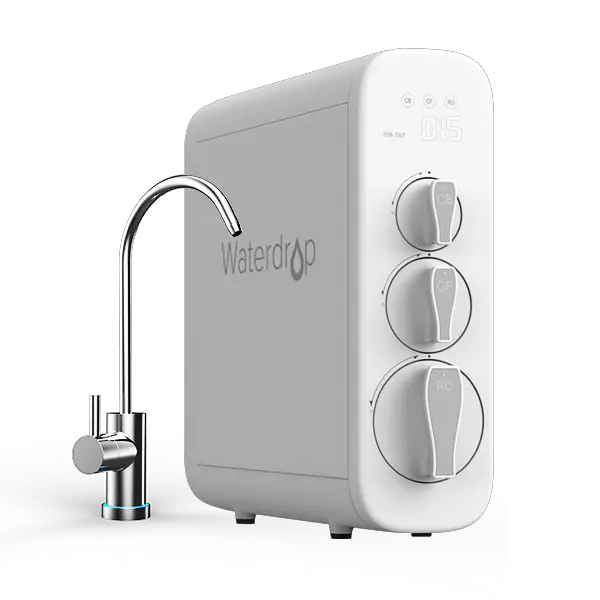
The WaterDrop G3 RO system has a wastewater to pure water ratio of 1:1.
There’s also an automatic feature that flushes out wastewater which prevents clogging up of the system and extends the life of the system.
The WaterDrop Reverse Osmosis system has been tested and certified against NSF/ANSI standard. It uses a lead-free system to purify water and provide safe and pure water for consumption.
It is efficient in the reduction of TDS, and removal of microbial and chemical contaminants. It has also been effective in the removal of chlorine taste and odor, and improving the overall freshness of the water. It also has a high flow rate, prevents bacteria formation within the system which improves water freshness.
WaterDrop also make an 800GPD Tankless RO system that has a wastewater to pure water ratio of 1:3, which is excellent!
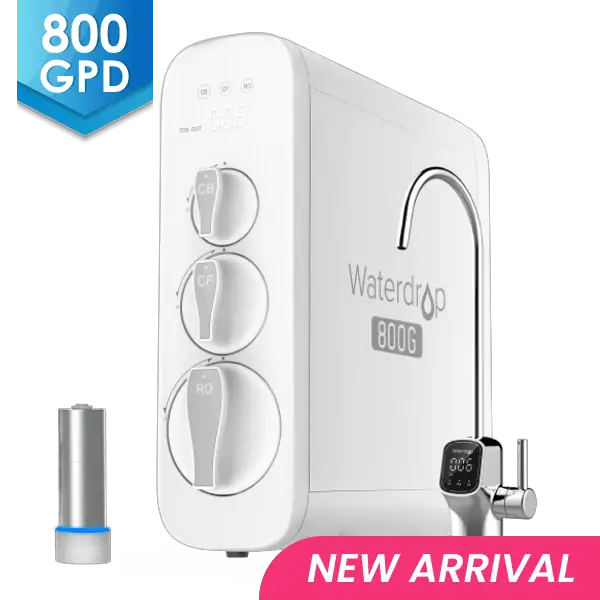
This is superior to the WaterDrop G3 and also comes with a powerful UV Sterilizing light.
The WaterDrop 800GPD has an equal best pure water producing capability of all the reverse osmosis systems on our list.
The WaterDrop N1 reverse osmosis system is the only other RO system on our list that has a 1:3 wastewater to pure water ratio.
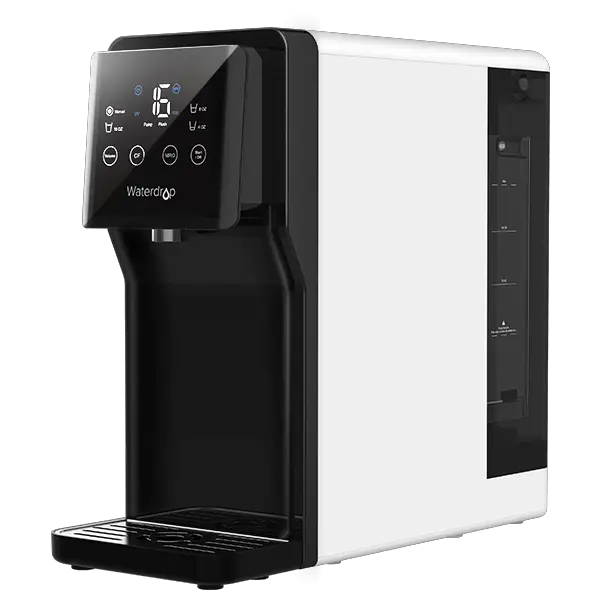
One of the best things about this countertop RO compared to other brands is that absolutely no plumbing, drilling, or installation is required.
You simply plug it in, top up the reserve tank, and use it like a refrigerator water dispenser. Perfect for an RV, kitchen or office space!
2. Brio Reverse Osmosis System
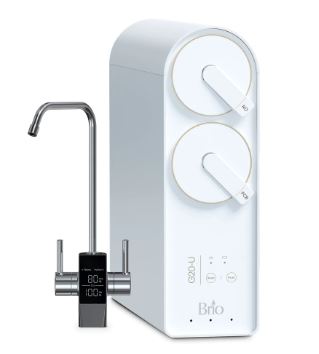
This Brio RO system has a wastewater to pure water ratio similar to the Nu Aqua system – 1:2 which makes it a highly conservative system.
The Brio RO system has a long-lasting integrated set of filters and self-cleaning abilities, which improves maintenance, and it gives you access to water of varying temperatures; cold, warm or hot. It also features a multiple water dispenser system with about 4 stages of filtration for highly purified water.
It also has very fast water flow and a TDS meter which gives you accurate reading of contaminant level before and after filtration.
This system is available direct on Briowater.com or from Amazon.
3. Frizzlife Reverse Osmosis System
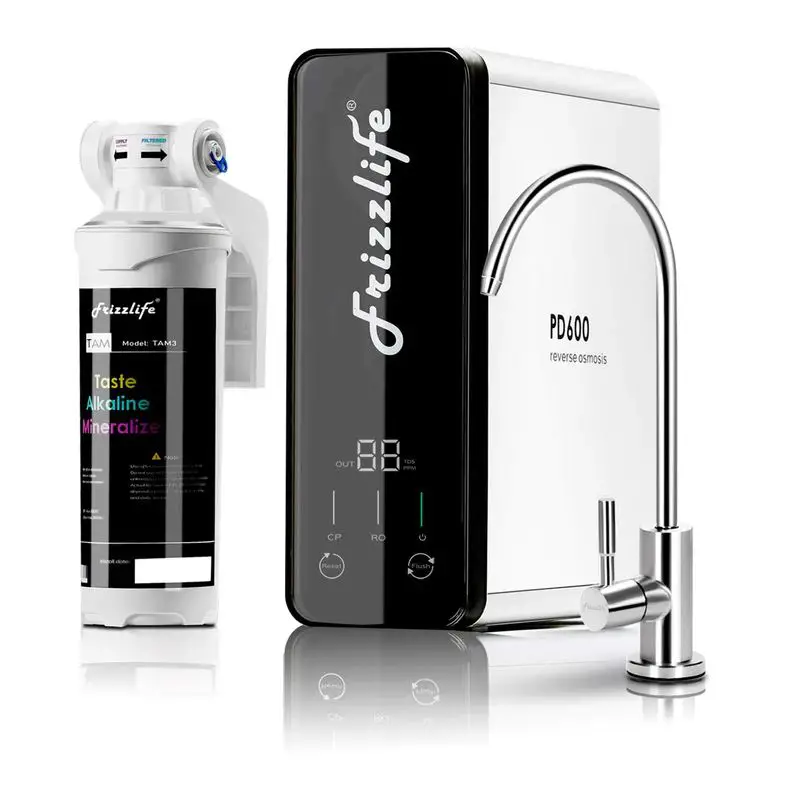
Most RO products from Frizzlife have a high-water saving capacity with a wastewater to pure water ratio of 1:1.5, and sometimes 1:1.
The TAM3 Frizzlife Reverse Osmosis system (pictured) has a 1:1.5 watewater to pure water ratio. It produces purified water that is slightly alkaline (~pH 7.5) which tastes great! This RO system removes over 1000 contaminants, has a high and stable water flow rate, and produces a massive 600 gallons of water per day.
This capacity can be attributed to the impressive water pressure in the system and the rapid water flow. Compared to traditional RO systems, these systems are economical and environmentally friendly.
They also feature a smart display system that acts as a reminder for the prompt replacement of RO membrane and other filters.
4. NU Aqua Reverse Osmosis System
This Nu Aqua RO system has a wastewater to pure water ratio as low as 1:2. This implies that as opposed to the general 4:1 ratio, this system produces even more pure water than wastewater.
The NUAqua system is a high-quality Reverse Osmosis system that produces great tasting water at a highly efficient flow rate. It has six stages of filtration that removes dirt, rust, chemicals, and microorganisms. The filters have indicators (smart system reminder) that notify you when it’s time for a replacement.
The RO membrane filter has a lifespan of 36 months which means that you’d only need to replace them once in three years, or in peculiar situations where there’s an obvious decline in system efficiency.
5. Home Master Reverse Osmosis system
The HomeMaster RO system has 50% efficiency which means that the wastewater to pure water ratio is 1:1.
The Home Master brand produces RO systems with fairly different characteristics in terms of certain properties. This brand reduces the wastewater production by offering an optional permeate pump upgrade kit (link to Amazon) that is compatible with all models of their RO filtering systems.
You can learn more about the permeate pump for RO system, and how it works as you progress in this article.
The permeate pump helps to solve the problem of slow flow rate, TDS creep, and reduced membrane efficiency.
Home Master RO systems make use of catalytic carbon filtration media for the removal of several chemical contaminants, and has a remineralization system which balances water pH and improves water quality.
6. iSpring reverse osmosis system
The wastewater to pure water ratio of the iSpring RO system is 3:1 which is a little high but still conservative compared to traditional systems.
iSpring is a top-rated manufacturer of water filtration systems that uses an integrated UV filter for water purification and extra protection against pathogens. The RO system has multiple stages of filtration equipped with filters made of different materials for increased efficiency.
It is most commonly used for well water purification. It also has a booster pump that produces a large amount of water in a high flow which eliminates the need for a storage tank.
7. APEC reverse osmosis system
The wastewater to pure water ratio in this APEC RO system is 3:1; for every gallon of pure water, three gallons of water are sent down the drain.
APEC has multiple years of experience designing some of the best water filtration systems available. It has several models of reverse osmosis systems that are suitable for indoor use.
APEC RO’s are certified with WQA Gold Seal which means that the systems manufactured are made from safe materials and have a high rejection rate for contaminants.
The RO filtration systems contain filters made of materials such as calcite, carbon block, and coconut shell carbon.
These systems are easy to install, have high flow rates, and produce clean and safe drinking water.
The system is easy to maintain and often requires an annual filter replacement. There is also a remineralization chamber that replaces beneficial minerals that the system might have removed as a contaminant. This contributes to the taste and nutritional quality of the water produced.
APEC RO systems are typically free from clogs and leaks and has high feed water pressure ranging from 40-85psi. See their full RO range here on Amazon.
8. Pentair Pelican reverse osmosis system
This 5-Stage Pentair pelican RO system has an air-gapped faucet that prevent wastewater from re-entering the filtration system and have a wastewater to pure water ratio of 2.5:1.
The Pentair pelican RO system is certified by NSF/ANSI standards 42, 53 and 58, that is, it is capable of removing up to at least 58 known contaminants.
Despite the amount of water it uses (wastes) in the production of one gallon of pure water, compared to other RO systems on our list, it is very efficient with easy maintenance and installation.
9. PureDrop reverse osmosis system
Like the APEC and iSpring, this PureDrop RO system also has a wastewater to pure water ratio of 3:1.
With a smaller water capacity than most of its competition, PureDrop reverse osmosis systems feature multiple stage filtration technology. The systems produce contaminant-free water at a relatively high flow rate and with improved taste.
The system is generally free from leaks and has a high feed water pressure range that contributes to the reduction in wastewater compared to traditional RO systems.
10. Express Water reverse osmosis system
Depending on the pressure of the feed water, the wastewater to pure water ratio in this Express Water RO system is usually 3:1; the higher the pressure the lesser the amount of water used or wasted during filtration.
Express Water manufactures high efficiency filtration systems that produce safe and great tasting water. It is certified by NSF/ANSI standard 58 and has the ability to remove 99% of all kinds of contaminants from the feed water which improves the taste of the purified water. It also features environmentally friendly filters that give the water a natural taste.
Express Water RO systems are low maintenance, easy to install, and have highly effective contamination reduction, leak detection feature and a high water flow rate.
The different filtration stages contribute to removing dirt, rust, chemicals, and microbes to produce high quality water. The integrated double sealed filters that require annual replacement also contribute to the effectiveness of the system and prolonging its lifespan.
11. Aqua True reverse osmosis systems
This Aqua True RO system has a 50% water conservation efficiency which means for every gallon of pure water, there’s an equal gallon of brine sent to the drain (1:1).
Aqua True RO systems feature a multistage filtration system with activated carbon filters that may be changed at six months to years interval, and RO membrane that can last up to two years before replacement.
It is NSF certified to remove over 83 contaminants which ensures the production of highly pure and safe water. Aqua true RO system has an integrated pressure pump which increases water productivity and lowers reject water percentage.
The system is generally easy to install and maintain for household use.
12. Whirlpool reverse osmosis system
This Whirlpool RO system has a wastewater to pure water ratio of 3.5:1 which might be considered high for some, but due to the presence of a long-lasting RO membrane filter and the overall quality of water produced, it could still be considered a conservative system.
Also certified by the NSF to remove various contaminants, Whirlpool RO systems hav a multistage filtration system that remove microbial cysts, hard metals, sediments, and unpleasant tastes and odors from the feed water.
The filters would require biannual changing which you’re unlikely to forget, thanks to the smart reminder feature. It is easy to install, use and maintain.
Summary of RO systems that produce low amounts of wastewater
The table below is a summary of the different brands of Reverse Osmosis systems with their wastewater (goes to drain) to pure water (what you drink) ratio after filtration.
They are ordered from the best to worst:
| RO system | Ratio | Drain | Pure |
| WaterDrop 800GPD | 1:3 | 1 | 3 |
| WaterDrop N1 | 1:3 | 1 | 3 |
| Nu Aqua | 1:2 | 1 | 2 |
| Brio | 1:2 | 1 | 2 |
| Frizzlife | 1:1.5 | 1 | 1.5 |
| WaterDrop G3 | 1:1 | 1 | 1 |
| Home Master | 1:1 | 1 | 1 |
| Aqua tru | 1:1 | 1 | 1 |
| Pentair Pelican | 2.5:1 | 2.5 | 1 |
| iSpring | 3:1 | 3 | 1 |
| APEC | 3:1 | 3 | 1 |
| PureDrop | 3:1 | 3 | 1 |
| Express Water | 3:1 | 3 | 1 |
| Whirlpool | 3.5:1 | 3.5 | 1 |
What is an RO permeate pump?
An RO system with a permeate pump (Amazon example) is one with increased filtration efficiency and reduced amount of generated wastewater by up to 80%. A permeate pump is a non-electric pump that uses the water sent to the drain after filtration to generate energy, and produces clean water with higher quality, at a great flow rate.
What is “permeate” in reverse osmosis?
In a reverse osmosis system, “permeate” refers to the purified drinking water obtained after filtration. The membrane filter in the RO system removes contaminants from the feed water. The contaminants are washed out as reject water (also called brine or concentrate water) and the permeate water is transferred into the RO storage tank.
How does a permeate pump waste less water?
A permeate pump has a chamber where it uses the RO wastewater as an energy source to transfer the purified water into the RO storage tank. It has inlets and outlets for the wastewater and the purified water on its sides.
The permeate pump creates a barrier between the storage tank and the membrane which increases the water pressure and helps the membrane break through the resistance from the air compression present in a standard RO system.
The process involved in the permeate transfer and storage improves the performance of the RO system and the longevity of the membrane filters.
Is a permeate pump worth it?
A permeate pump offers increased pure water production, reduced wastewater production, improved system life and working efficiency as well as cleaner water.
If you’ve been concerned about the wastewater to pure water production ratio of your RO system, a permeate pump upgrade is well worth the investment.
Conclusion
The typical ratio for wastewater to purified water from a reverse osmosis system is 4:1.
However, this ratio can be greatly reduced by investing in high quality RO systems with updated technology alongside proper maintenance practices for your filtration system. You can also significantly reduce the wastewater by installing a permeate pump which will improve the efficiency of your RO system and reduce the water discharged to the drain.











